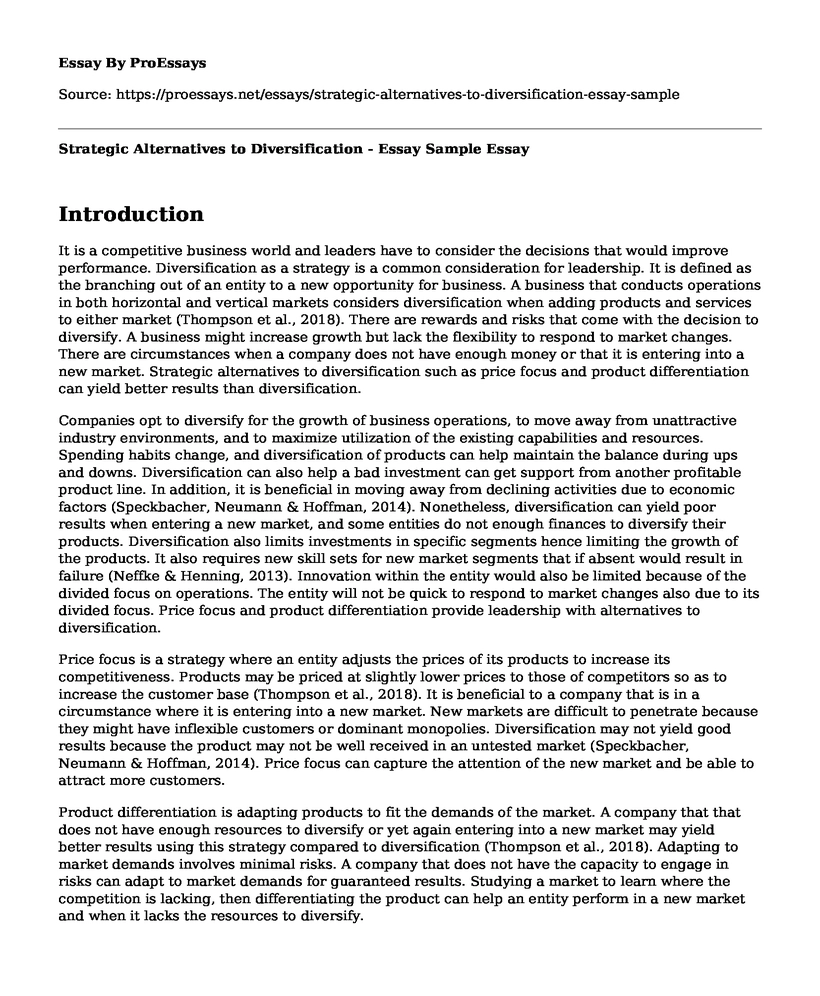Introduction
It is a competitive business world and leaders have to consider the decisions that would improve performance. Diversification as a strategy is a common consideration for leadership. It is defined as the branching out of an entity to a new opportunity for business. A business that conducts operations in both horizontal and vertical markets considers diversification when adding products and services to either market (Thompson et al., 2018). There are rewards and risks that come with the decision to diversify. A business might increase growth but lack the flexibility to respond to market changes. There are circumstances when a company does not have enough money or that it is entering into a new market. Strategic alternatives to diversification such as price focus and product differentiation can yield better results than diversification.
Companies opt to diversify for the growth of business operations, to move away from unattractive industry environments, and to maximize utilization of the existing capabilities and resources. Spending habits change, and diversification of products can help maintain the balance during ups and downs. Diversification can also help a bad investment can get support from another profitable product line. In addition, it is beneficial in moving away from declining activities due to economic factors (Speckbacher, Neumann & Hoffman, 2014). Nonetheless, diversification can yield poor results when entering a new market, and some entities do not enough finances to diversify their products. Diversification also limits investments in specific segments hence limiting the growth of the products. It also requires new skill sets for new market segments that if absent would result in failure (Neffke & Henning, 2013). Innovation within the entity would also be limited because of the divided focus on operations. The entity will not be quick to respond to market changes also due to its divided focus. Price focus and product differentiation provide leadership with alternatives to diversification.
Price focus is a strategy where an entity adjusts the prices of its products to increase its competitiveness. Products may be priced at slightly lower prices to those of competitors so as to increase the customer base (Thompson et al., 2018). It is beneficial to a company that is in a circumstance where it is entering into a new market. New markets are difficult to penetrate because they might have inflexible customers or dominant monopolies. Diversification may not yield good results because the product may not be well received in an untested market (Speckbacher, Neumann & Hoffman, 2014). Price focus can capture the attention of the new market and be able to attract more customers.
Product differentiation is adapting products to fit the demands of the market. A company that that does not have enough resources to diversify or yet again entering into a new market may yield better results using this strategy compared to diversification (Thompson et al., 2018). Adapting to market demands involves minimal risks. A company that does not have the capacity to engage in risks can adapt to market demands for guaranteed results. Studying a market to learn where the competition is lacking, then differentiating the product can help an entity perform in a new market and when it lacks the resources to diversify.
Business operations in both horizontal and vertical markets at times yield poor results when using diversification as a strategy. When a business is entering into a new market and lacks the necessary resources are circumstances when strategic alternatives to diversification might yield better results. Leadership can consider price focus and product differentiation as strategic alternatives to diversification. Price focus makes the products affordable and marketable while product differentiation addresses the needs of the customers.
References
Neffke F, & Henning M. (2013). Skill-relatedness and firm diversification. Strategic Management Journal, 34(3): 297-316
Speckbacher, G., Neumann, K., & Hoffmann, W. H. (2014). Resource relatedness and the mode of entry into new businesses: Internal resource accumulation vs. access by collaborative arrangement. Strategic Management Journal, 36(11), 1675-1687.
Thompson, A. A., Peteraf, M. A., Gamble, J., & Strickland, A. J. (2018). Crafting and executing strategy: The quest for competitive advantage: concepts and cases. McGraw-Hill Education.
Cite this page
Strategic Alternatives to Diversification - Essay Sample. (2022, Dec 12). Retrieved from https://proessays.net/essays/strategic-alternatives-to-diversification-essay-sample
If you are the original author of this essay and no longer wish to have it published on the ProEssays website, please click below to request its removal:
- Course Work on Risk Management and Organizational Change
- Why It Is Worth to Open a Restaurant Essay
- Implications and Challenges for Traditional Organizational Management Essay
- Essay Sample on Decision-Making During the Organizational Crisis
- The Hotel Simulation Tool Paper Example
- Leadership and Goals - Essay Sample
- The Feminism Management Theory and the Practice Management Theory Essay







